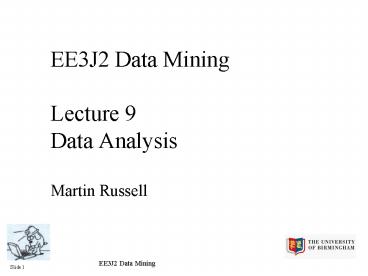EE3J2 Data Mining Lecture 9 Data Analysis Martin Russell - PowerPoint PPT Presentation
1 / 14
Title:
EE3J2 Data Mining Lecture 9 Data Analysis Martin Russell
Description:
EE3J2 Data Mining. Slide 1. EE3J2 Data Mining. Lecture 9. Data Analysis. Martin Russell ... is useful to subtract the mean (X) from each of the data points xt. ... – PowerPoint PPT presentation
Number of Views:42
Avg rating:3.0/5.0
Title: EE3J2 Data Mining Lecture 9 Data Analysis Martin Russell
1
EE3J2 Data MiningLecture 9Data
AnalysisMartin Russell
2
Objectives
- To review basic data analysis
- To review the notions of mean, variance and
covariance - To explain Principle Components Analysis (PCA)
3
Example from speech processing
- Plot of high-frequency energy vs low-frequency
energy, for 25 ms speech segments, sampled every
10ms
4
Basic statistics
5
Basic statistics
- Denote samples by
- X x1, x2, ,xT,
- where xt (xt1, xt2, , xtN)
- The sample mean ?(X) is given by
6
More basic statistics
- The sample variance ?(X) is given by
7
Covariance
- As the x value increases, the y value also
increases - This is (positive) co-variance
- If y decreases as x increases, the result is
negative covariance
8
Definition of covariance
- The covariance between the mth and nth components
of the sample data is defined by - In practice it is useful to subtract the mean
?(X) from each of the data points xt. The sample
mean is then 0 and
9
Data with mean subtracted
10
Sample data rotated through 2?
11
Data with covariance removed
12
Principle Components Analysis
- PCA is the technique which I used to diagonalise
the sample covariance matrix - The first step is to write the covariance matrix
in the form - where D is diagonal and U is a matrix
corresponding to a rotation - Can do this using SVD (see lecture 8) or
eigenvalue decomposition
13
PCA continued
U implements rotation through angle ? e1 is the
first column of U d11 is the variance in the
direction e1 e2 is the second column of U d22 is
the variance in the direction e2
e1
e2
?
14
Summary
- Basic data analysis
- Means, variance and covariance
- Principle Components Analysis































